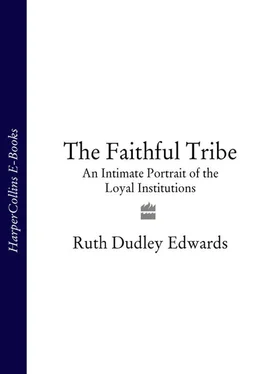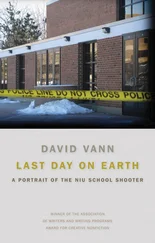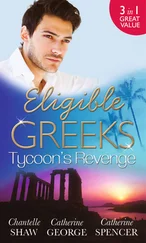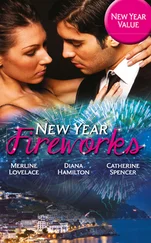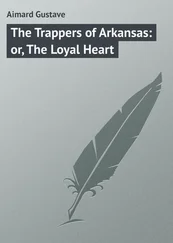Bands decide what to play. Lodges choose the bands. ‘In my young days, the bands were all flute bands,’ recalled Worshipful Master Charlton from Mourne. ‘There were no uniforms. And I remember our band had old police caps. I remember going and getting a bag full of discarded police caps and the women making white tops and putting a bit of elastic in them to go over the top of the caps. And getting blue ribbon and the women putting blue ribbons on them. And I remember going to Belfast and getting badges. The blue ribbons were because our lodges are blue.
‘Now we’ve an Irish pipe band here. In Mourne there are accordion bands, pipe bands and harp bands. I was just talking to a wee girl there, her harp and flute band, they won the Ulster championship in the Ulster Hall on Saturday. And they’ve practised in our hall. There’s better music now, but by and large the Orange hasn’t changed much. Only just the standard of living.’
There are devotees of all kinds of bands, but the instruments most associated with Ulster are the flute (or fife, the small, shriller version) and the drum. Alvin Mullan wrote in 1997:
My background is rooted in [the flute band] tradition and can be traced to the late nineteeth century, when on the Twelfth 1890 my great-grandfather Alvin Mullan began playing the fife along with the drums for an Orange lodge from Tullyhogue in Co. Tyrone, as part of the demonstration. Continuing this tradition, my grandfather William Mullan, a gifted drummer, led the drum corps in Killymoon Flute Band, the local part-music flute band from Cookstown, Co. Tyrone. Due to ill health my grandfather’s mantle was inherited by my father William Alvin Mullan, who led the drum corps of the band until it folded up in the 1970s (this band has recently been reformed under the same name and maintains the part-music flute band tradition in that area).
This background caused me, from an early age, to view the Twelfth as an occasion to listen to bands, view the impressive display of musical culture and long for the day when I could participate. This finally materialized on the Twelfth 1981 when I played the flute with Tullyhogue Flute Band in Cookstown on the return parade from the main demonstration. Thus my band career was launched and still continues with Corcrain Flute Band from Portadown (which I joined in 1985).
As a bandsman I regard the Twelfth as the most important parade of the year; all other parades prior to this are preparatory and any following are extra. The occasion demands much preparation. One’s flute must be in top working order, the uniform clean with trousers well pressed, the shirt snow-white and ironed in case the weather demands the removal of the tunic, shoes must be gleaming, and the music holder well polished. When the band moves off on the morning of the Twelfth it is really a most enjoyable and thrilling experience. All the preparation and months of practice result in a fine display of musical talent as the band plays through its march repertoire: Galanthia, The Bulgars’ Entry, Le Tambour Major, Our Director, The Pacer, Peace and Plenty, The Gladiator’s Farewell, Corcrain, Coeur de Lion and others.
In addition to the musical aspect of playing in a flute band on the Twelfth, there is also the opportunity to meet other bandsmen and listen to their music. There exists amongst bandsmen a great sense of comradeship and unity of purpose. The Twelfth provides opportunity to develop this by renewing friendships, discussing problems, swapping ideas, and reflecting on past Twelfths. As a bandsman the Twelfth means everything; it is the heart of the flute band tradition, its soul and life. Remove the Twelfth and the tradition will die.
In the early nineteenth century, Ulster flute bands came into existence, modelled on those that formed part of military bands. Initially, they played military music and paraded in martial style. Their repertoire broadened as their range of instruments increased; from 1907 these sophisticated part flute bands, complemented by a drum corps, have engaged in music contests.
The part flute bands are for connoisseurs; the ‘blood and thunder’ or ‘kick-the-pope’ bands are populist. Dominic Bryan, an academic who with Neil Jarman has done much to explain what parades are all about, exactly expresses my own mixed feelings about them.
Blood-and-thunder bands can be threatening to an outsider like myself and it is easy to appreciate why so many in the Catholic community treat them with a mixture of fear and loathing. On the other hand they are also the most entertaining part of the Twelfth in Belfast. They help create a sense of carnival which is in some contrast to the officials at the front of the parade and the religious service given at the field.
He remarks about the uniforms: ‘On the one hand you have plenty of sombre dark respectable suits whilst some of the bands are in bright orange, blue and purple uniforms. And there is invariably a group of young girls dressed in the latest fashion (or the latest Rangers shirt) walking alongside their band: the Twelfth is also about teenage sexuality.’
While most bands include women of all ages, teenage sexuality is most evident among the fife-and-drum groupies or the mini-skirted standard-bearers who march in front of the most villainous-looking bands. These bands have vastly increased in number over the last thirty years as a reaction to the Troubles. Many Orangemen who hate the militarism of these bands argue that they are a vital safety-valve for young people who might otherwise become involved in paramilitary violence and that their contact with the Orange Order is crucial. ‘I was not long a member of a flute band when one of our drummers was murdered by the IRA,’ one now senior Orangeman told me. ‘Some of us kids were full of rage. It was only the influence of older Orangemen in our lodge that stopped us getting guns; some of us would have gone out to get revenge.’
The flute bands also have the merit of being cheap. It is extremely expensive to support, for instance, a silver or a pipe band: £2,000 is nothing for a trombone. And for those lodges which hire bands, the choice can be between paying £500 for a silver band or £100 for the fife-and-drum equivalent.
The famous Lambeg drums never appear in Belfast now, but drumming matches are still popular in rural areas. The Lambeg’s origins are disputed, but it is agreed that it is the ultimate tribal symbol in Ulster. It is no accident that Lambeg drumming is strongest in Armagh, where republicanism is at its most entrenched and dangerous. The staccato beat can be heard for miles, even in bandit country.
Food
There are, in my experience, two expressions so miserable as to strike pity into the hardest heart. One is that of an Indian shopkeeper who fails to make a sale; the other, of an Ulster Protestant who has discovered his dinner will be late.
Rural Protestants in particular are people with few vices; fidelity and temperance are the norm. But they do love food. I kept track one day of the eating activities of a group of Orangemen. I had arrived in Belfast at eight o’clock and was taken to a friend’s house. The woman of the house, her daughter and daughter-in-law were preparing for the arrival at ten o’clock of three or four guests, who were being lavishly catered for despite the fact that there was no doubt that they would have had an Ulster fry two hours previously.
By the time the dignitary – the local county Grand Master – and the others arrived, the table was covered with five different kinds of sandwiches, sausages and home-made sausage rolls, home-made cakes and pies. There was orange squash, there was tea and there was coffee. And throughout the meal, as throughout so many of the meals I’ve had in Ulster, people looked at me in a worried fashion because to them my appetite seemed so small as to run the risk of my expiring at their very table from malnutrition.
Читать дальше
